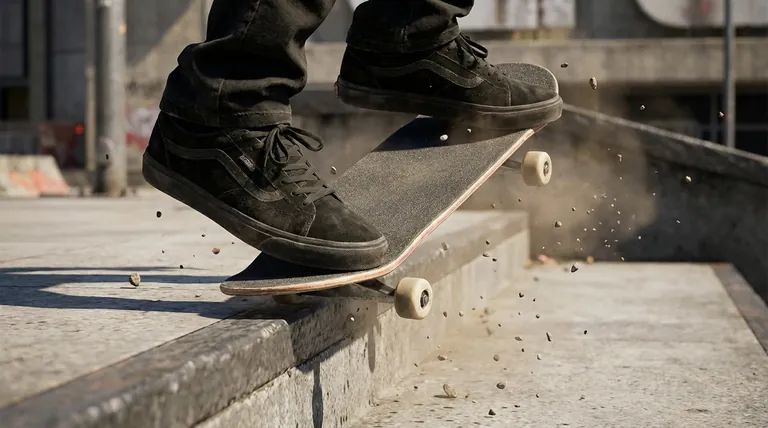Vulcanized shoes are the definitive choice for a specific style of skateboarding. They are best suited for technical, low-impact street or transition skating where an intimate connection to the board is paramount. Skaters who prioritize flip tricks, grinds, and precise control will find that vulcanized construction offers an unmatched level of feel and feedback.
The core principle of a vulcanized shoe is a strategic trade-off: it deliberately sacrifices maximum impact absorption in exchange for superior boardfeel, flexibility, and grip, making it the ideal tool for skaters who require ultimate control.

The Defining Feature: Unmatched Boardfeel
The unique properties of a vulcanized shoe stem directly from its manufacturing process. This process is what gives the shoe its signature flexibility and sensitivity.
How Vulcanization Works
A vulcanized shoe is constructed by using a high-temperature baking process, similar to an oven, to cure the rubber components. The rubber outsole and foxing tape (the strip of rubber that wraps around the shoe) are essentially melted and fused directly to the shoe's upper, creating a single, unified piece.
The Thin Outsole Advantage
This construction method results in a characteristically thin and flat outsole. This minimal layer of material brings your foot closer to the board, dramatically enhancing your ability to feel its concave and edges. This heightened sensitivity provides the feedback needed for subtle foot adjustments during technical maneuvers.
Flexibility Straight From the Box
Because the sole is cooked to the upper, the shoe is inherently flexible and requires virtually no break-in period. This immediate pliability allows for a natural range of motion, giving you responsive control from the very first wear.
Where Vulcanized Shoes Excel
The unique characteristics of vulcanized shoes make them the superior choice for specific disciplines within skateboarding.
Technical Street Skating
For tricks like kickflips, heelflips, and grinds, precise foot placement is non-negotiable. The excellent boardfeel of a vulcanized shoe allows a skater to feel exactly where their feet are, ensuring consistent flick and catch for flip tricks and confident locking-in on ledges and rails.
Transition and Bowl Skating
When pumping through a bowl or carving a transition, grip and feel are essential for maintaining momentum. The grippy, sensitive sole of a vulcanized shoe helps the skater feel the curve of the transition, allowing for better control while generating speed.
Understanding the Trade-offs
No single shoe design is perfect for every application. The strengths of the vulcanized shoe come with clear compromises that are critical to understand.
The Compromise on Impact Protection
The primary trade-off is cushioning. The same thin sole that provides incredible boardfeel offers minimal protection from high-impact landings. This makes vulcanized shoes a poor choice for skating large stair sets, gaps, or anything involving significant drops.
Durability Considerations
The single, fused layer of rubber around the shoe can wear down with repeated abrasion from griptape, particularly in high-wear areas from ollies and flip tricks. While designs have improved, they often have a shorter lifespan for a high-frequency skater compared to more heavily constructed alternatives like cupsoles.
Making the Right Choice for Your Skating
Ultimately, the best shoe is the one that aligns with your specific goals and skating style.
- If your primary focus is technical precision: Vulcanized shoes offer the unparalleled boardfeel and control you need for flip tricks and intricate ledge or manual skating.
- If your primary focus is high-impact skating: You should strongly consider a cupsole shoe, as vulcanized construction lacks the necessary cushioning and support for big drops.
- If you are a beginner: A vulcanized shoe is an excellent starting point because its immediate flexibility and sensitivity will help you learn how the board responds to your foot movements.
Choosing your shoe is about aligning your equipment with your intention; for control and feel, vulcanized construction is the superior tool for the job.
Summary Table:
| Feature | Vulcanized Shoes | Best For |
|---|---|---|
| Boardfeel | Excellent (thin sole) | Technical tricks, precise control |
| Flexibility | High, no break-in | Responsive movements, carving |
| Impact Protection | Low (trade-off) | Low-impact skating, not large drops |
| Durability | Moderate | Skaters prioritizing feel over longevity |
Ready to equip your skaters with the ultimate tool for control?
As a large-scale manufacturer, 3515 produces a comprehensive range of vulcanized footwear designed for the technical demands of modern skateboarding. We provide distributors, brand owners, and bulk clients with high-quality shoes that deliver the superior boardfeel and flexibility skaters demand.
Contact 3515 today to discuss your vulcanized shoe needs and enhance your product line with performance-driven footwear.
Visual Guide

Related Products
- Wholesale Breathable Training Shoes Custom Athletic Footwear Manufacturer
- Lightweight Breathable Training Shoes for Wholesale & Custom OEM Manufacturing
- Wholesale Breathable & Cushioned Training Shoes Custom Factory Production
- Wholesale Training Shoes with Dial Lacing System Custom OEM Manufacturing
- Wholesale Durable & Breathable Training Shoes for Custom Brands
People Also Ask
- What are the benefits of breathable materials in work shoes? Enhance Comfort & Health for Your Workforce
- What are the characteristics of canvas as a shoe material? A Guide to Lightweight, Breathable Footwear
- Why are running shoes and walking shoes not interchangeable? Avoid Injury with the Right Footwear
- What are the benefits of athletic-style work shoes? Boost Comfort and Safety for Your Team
- What are the benefits of breathable mesh in shoe design? Enhance Comfort and Performance



















